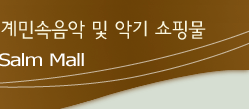|
|
 |
|
|
 |
|
중동 전통 북인 다르부카(Darbuka)
'둠벡'이라고도 불리는 '다르부카'는 과거에는 물고기나 동물 가죽의 헤드에 진흙으로 구운 몸체를 사용했으나 현대에 와서 알류미늄, Brass 몸체에 현대식 막을 사용한다.
* 재질 : 알류미늄(블루색,마블무늬)
* 사이즈 : 23*36cm
* 소프트 케이스 포함
Darbuka is called as dümbek, dümbelek, deplek, deblek, dönbek, tömbek, darbeki and debulak. This percussion instrument was originally made using baked earth, although this increasingly gave way to such materials as copper, aluminium, various metal compounds, plaster, porcelai wood and glass fibres. Generally speaking, the darbuka resembles a pipe with one narrow end and one wide one, and was formerly covered in leather, although synthetic materials are now preferred.
|
|
|
|
|
* 배송료
안내- 5만원 이상은
무료, 5만원
미만은 배송료(제주도 등 도서지방 제외) 4,000원 |
|
|
|
|




 [소리삶] 대표: 이영진
[소리삶] 대표: 이영진 주소 : 경기도 파주시 탄현면 헤이리마을길 63-26 Tel : 031)946-9810 Fax : 031)946-9812
주소 : 경기도 파주시 탄현면 헤이리마을길 63-26 Tel : 031)946-9810 Fax : 031)946-9812 사업자 등록번호 128-19-90855
사업자 등록번호 128-19-90855  통신판매업 허가번호 : 고양시 제 55호
통신판매업 허가번호 : 고양시 제 55호
